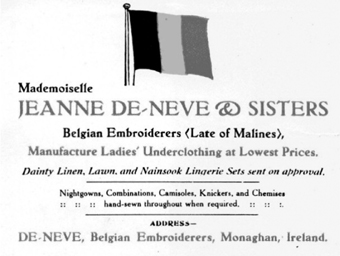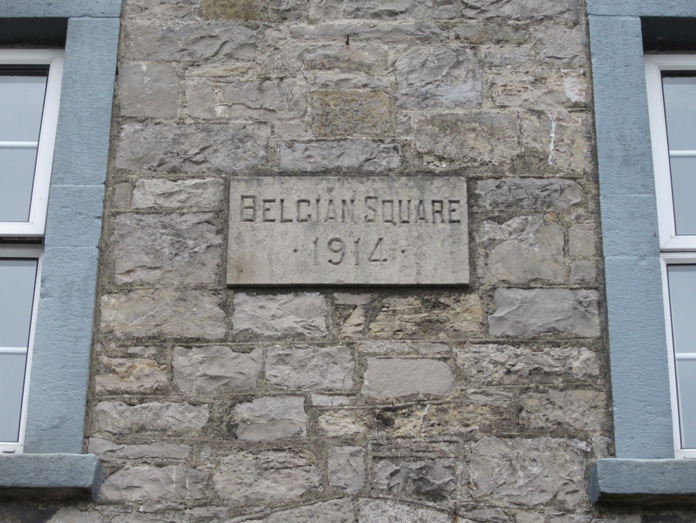Building of the Month - July 2015


In 1912 Monaghan Urban Council began to plan a scheme of artisans’ houses to be financed under the Housing of the Working Classes (Ireland) Act, 1908. This Act, designed principally to rid Irish cities of slum dwellings, allowed urban councils to access loans at reasonable rates. The disused military barracks on the outskirts of the town was identified as a suitable site for the scheme and John Joseph Inglis (1872-1926) of Dublin was appointed as architect in May 1913. His fee was £200 plus rail fares and he insisted on travelling first class.
At the council’s meeting in November 1913 it was decided that the barracks would be retained and converted into eleven artisans’ houses. Sixteen new three-roomed houses – arranged in blocks of four with gardens to the end houses – would be built between the entrance gate and the front block of the barracks. These houses today seem compact, but they were originally to be even more petite. Inglis successfully argued for their eventual size saying that anything smaller would not meet legal requirements.
Inglis was slow in delivering plans for the scheme. Eventually he was given a week to produce the plans or else face losing the contract. He complied promptly. The council agreed that twelve new four-roomed houses would be built along the main road ‘so as to make a proper frontage’ but these houses, now called New Terrace, were not begun until 1922.
In January 1914 the Board of Works approved a loan of £4,000, repayable over sixty years, to cover the cost of the scheme. Work was underway by the following May. Two men from Belfast were appointed as contractors: Issac Copeland to convert the existing barracks (£995) and Patrick Ritchie to erect sixteen new houses (£2,089) along with fences and gates (£218).
As work progressed through the summer of 1914, the First World War broke out in Europe. The papers in County Monahan were full of reports of local soldiers injured or killed on the Front and war news from all over the world. The papers also reported on the plight of Belgian civilians. On the 12th of September, for instance, the Northern Standard told of one hundred civilians slain by the German army at Dinant. Boatloads of Belgian refugees began to arrive on the shores of England – up to 4,000 a day by the end of September. In all it is estimated that a quarter of a million displaced Belgians arrived in England during the first eighteen months of the war, the largest movement of people ever to have fled to Great Britain in a refugee crisis. About 3,000 were sent on to Ireland.
On the 31st of October, 1914, fifteen Belgian refugees arrived at Monaghan Railway Station on the 9.50 train from Belfast. They included Madame von Crombrugger and her daughter Francine; Edmond Goossens; Matilda and Peter Loots; the Wallaerts; and an extended family consisting of Hubert and Anna De Neve, their children Isabelle (“Izette”), Jeanne and Sylvie, Bertha De Neve, and their nephew August Gillé and his mother Marie. A large crowd led by Leonie Leslie greeted the refugees at the station. Lady Leslie assumed the role of guardian to the Belgians throughout their stay in Monaghan and well after they had departed and, under her direction, the ladies of the refugee committee supplied the houses with bedding, furniture and food.
.jpg)
Figure 2: A photograph taken on the 1st of November, 1914, showing some of the Belgian refugees. Pictured, from left to right, are: Madame von Crombrugger with her daughter Francine; Anna and Hubert De Neve; Jean Wallaert; an unidentified gentleman in a flat cap; and Peter and Matilda Loots. Courtesy of the Leslie Archive, Glaslough
The whole of the rear barracks block was occupied the refugees – four houses in all – along with at least one of the new houses. As a result of their arrival some local tenants who had been promised one of the artisans’ houses were assigned to other houses in the locality. Some did not get houses at all.
| On the 1st of November, 1914, a collection in support of the refugees was taken at Saint Macartan’s Cathedral. Hundreds of locals of all social classes made donations ranging from one shilling to £10. A list of contributions to the Belgian Guests Committee gives the names of those who donated large sums – half were women – and some of the people who were prepared to subscribe weekly. Interviews with the refugees appeared in the Northern Standard with Professor Wallaert recounting a horrifying story of a young Belgian blacksmith who had both his hands chopped off for refusing to shoe the horse of a German soldier. The professor himself had lost all of his personal possessions when the Germans threw lighted sticks ‘covered with tar and naptha’ through the windows of his house and burned it.
The Belgians were expected to “muck in” and earn their keep and they lost no time in finding employment. Professor Wallaert gave classes in French at the YMCA. Work was found for the men in carpentry with August Gillé finding employment in McDonagh’s furniture factory in Richhill, County Armagh. However, the problem was finding work for the women. The De Neve sisters began making items of embroidery and the enterprising Jeanne had a business card made up decorated with the Belgian flag. |

Courtesy of Adrienne Czerwin-Abbot |
The Belgians must have endeared themselves quickly to the locals of Monaghan as at the council’s meeting on the 5th of January, 1915, William Breakey proposed that the barracks housing scheme should be named “Belgium Square”. He also proposed that the block where the Belgians were living should be given the name “Maline Terrace”, a reference to the town they were forced to flee. The council passed the motion. At a meeting on the 31st of March, 1915, it was agreed to have the name “Belgium Square” carved on a plaque. The plaque, placed high above the archway of the central block, is inscribed “Belgian Square 1914″.

Just before leaving Monaghan, Peter and Matilda Loos wrote a touching letter published in the Northern Standard on the 8th of February, 1919:
“On the eve of our departure to our motherland, we have the honour to pay a public homage to the good people of Monaghan for the kind hospitality which we have always received amongst them during all the duration of our exile. Our first duty is to testify our profound thankfulness to Lady Leslie, who was so kind as to come and take us up to London and to bring us amongst this sympathetic people, and who assisted us so largely by her gracious generosity. We thank very heartily the ladies and gentlemen who, since the beginning of our story, placed themselves at our disposal, paying us their best attentions, and by their devotedness and goodness beyond all praise have sweetened the bitterness of our exile.
“We publicly thank the good people of Monaghan for the great sympathy they have always shown us. From our arrival here they met us with smiles of welcome, and it is for us a great pleasure to feel that we retain their good friendship.
“We will always have a grateful remembrance of this noble country of Ireland, which has become for us our second home, and it is with our hearts full of thanks that at the last hours of our exile we express our feelings of eternal gratitude.
“We bid you not farewell, but au revoir,
“Peter and Matilda Loots, Belgian Refugees”
Grace Moloney is a County Monaghan historian whose main interests are archaeology, natural history, social history (especially women) and language